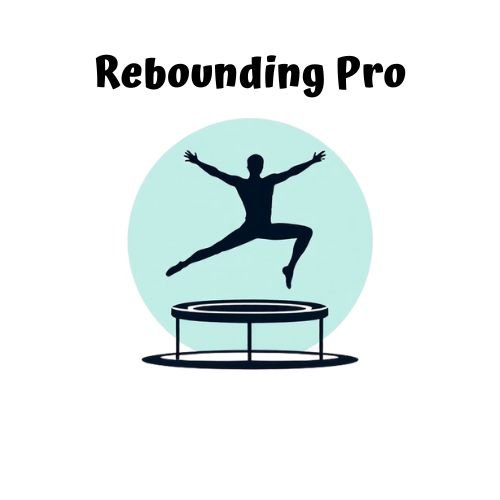Mini trampoline workouts can burn 300-470 calories in just 30 minutes, making them 2-3 times more effective than jogging. You’ll burn more calories with higher intensity—aim for vigorous bouncing at 14.4 calories per minute versus moderate at 12.4. Your weight, fitness level, and exercise style all affect your results. For maximum calorie burn, incorporate interval training and varied movements like jumping jacks and high-knees. Discover how proper technique and workout structure can double your calorie-burning potential.
Burn 300+ Calories With Mini Trampoline Workouts

When it comes to efficient exercise options, mini trampoline workouts stand out as calorie-burning powerhouses. You’ll torch between 372-470 calories in just 30 minutes, depending on your intensity level.
Your body weight greatly impacts results—heavier individuals naturally burn more calories. Ramping up intensity dramatically increases expenditure, with vigorous bouncing burning 14.4 calories per minute compared to 12.4 during moderate sessions.
Body weight and intensity drive results – heavier jumpers burn more calories, while vigorous bouncing maximizes every minute on the mini trampoline.
Mini trampoline workouts outperform many traditional exercises, burning 2-3 times more calories than jogging while being gentler on your joints. These workouts provide exceptional stress relief benefits through endorphin release, improving your mood while you burn calories.
For maximum results, incorporate interval training with 1-minute high-intensity bursts, full-body movements, and maintain at least 120 jumps per minute.
Track your progress using MET calculations, wearable tech, or online calculators to optimize your routine over time.
The Science Behind Rebounding Calorie Burn
Rebounding workouts tap into fascinating scientific principles that explain their impressive calorie-burning potential. When you bounce, your body experiences G-force during deceleration, dramatically increasing pressure on muscles and boosting calorie expenditure.
Unlike traditional exercises, rebounding engages multiple muscle groups simultaneously, creating a full-body workout that maximizes energy use. Your cardiovascular system responds by elevating your heart rate, further enhancing calorie burn.
What makes rebounding particularly effective is how it activates your lymphatic system while strengthening muscles and bones. NASA research shows rebounding can be 68% more effective than jogging at similar speeds. Studies show it can be more efficient at burning calories than running or swimming in less time.
For ideal results, vary your intensity during workouts and maintain consistency. Your weight, age, and workout duration will influence your specific calorie burn, but most people can achieve 300+ calories with proper technique.
How Many Calories Can You Actually Burn in 30 Minutes?

Four key factors determine your mini trampoline calorie burn: weight, intensity, fitness level, and exercise style. Most people can expect to burn between 150-240 calories during a 30-minute rebounding session, though this varies considerably based on effort level. Incorporating HIIT techniques with your trampoline workout can significantly increase your overall calorie expenditure.
| Weight | Moderate Intensity | Vigorous Intensity |
|---|---|---|
| 150 lbs | ~165 calories | ~430 calories |
| 180 lbs | ~200 calories | ~515 calories |
| 200 lbs | ~220 calories | ~575 calories |
At moderate intensity (3.5 MET), you’ll burn approximately 5.5 calories per minute if you weigh 150 pounds. Ramping up to vigorous intensity can more than double your calorie burn to 14.4 calories per minute. This makes rebounding comparable to jogging, but with less joint impact and more fun.
Weight Factors: How Your Body Mass Affects Calorie Burn
Your body weight plays a considerable role in determining how many calories you’ll burn on a mini trampoline. If you have a higher body weight, you’ll generally burn more calories during your bounce sessions because your body requires more energy to propel itself.
However, body composition matters too. Having more muscle mass considerably increases your calorie burn both during workouts and at rest. This directly relates to your basal metabolic rate, which is significantly higher in people with greater muscle tissue. Even with the same body weight, you’ll burn more calories if you have more muscle tissue.
Interestingly, organ size also affects your calorie expenditure. Larger internal organs consume more energy during exercise.
As you lose weight through trampolining, you may notice your calorie burn decreases slightly, but continuing to build muscle can help counteract this effect.
High-Intensity vs. Low-Intensity Rebounding

When deciding between high-intensity and low-intensity rebounding workouts, you’ll need to evaluate your fitness goals and physical condition.
High-intensity sessions elevate your heart rate to 150-160 bpm, burning approximately 87-146 calories per session while providing greater cardiovascular benefits.
High-intensity rebounding pushes your heart rate to 150-160 bpm, maximizing calorie burn and cardiovascular gains in every bounce.
Low-intensity rebounding keeps your heart rate around 127-137 bpm, burning 65-138 calories with less joint stress—ideal for beginners or recovery days. The bungee cord options provide an even gentler impact compared to spring-based rebounders, making them perfect for those with sensitive joints.
Both intensities strengthen muscles and bones by distributing impact forces evenly.
For maximum efficiency, consider NASA’s findings: 10 minutes of rebounding equals 30 minutes of running with less strain.
You’ll get best results by combining both intensities in your routine—using high-intensity intervals for cardiovascular improvement and metabolic conditioning, while low-intensity helps with recovery and building foundational fitness.
Mini Trampoline Workout Routines That Maximize Calorie Burn
You’ll burn more calories by incorporating interval training that alternates between high and low-intensity bouncing periods.
Adding variety to your bounce techniques—mixing jumping jacks, twists, and high-knee movements—engages different muscle groups and increases overall energy expenditure.
The effectiveness of your mini trampoline workout depends less on duration and more on how intensely you’re pushing yourself during each session.
For maximum results, consider adding HIIT workouts to your routine, as they can significantly boost calorie burn while maintaining low impact on your joints.
Interval Intensity Matters
While many fitness enthusiasts enjoy the gentle bounce of mini trampolines, the secret to maximizing calorie burn lies in interval intensity.
Research shows you can torch up to 470 calories in just 30 minutes of high-intensity rebounding—comparable to running at 8 mph.
The key is monitoring your heart rate, aiming for 70-85% of your maximum during work intervals. You’ll burn considerably more calories at RPE 8 (high intensity) than at RPE 5-6 (moderate intensity).
Your weight also factors in—heavier individuals burn more calories as their bodies work harder against gravity. The study demonstrated this clearly with Alex burning nearly twice as many calories (138) as Sydney (65) during the same low-intensity workout.
For ideal results, alternate between 30-second high-intensity bounces and recovery periods. This approach not only maximizes calorie burn during your workout but elevates your metabolic rate afterward, continuing the fat-burning effect.
Bounce Variety Techniques
The right bounce variety on your mini trampoline can transform an ordinary workout into a calorie-torching powerhouse. By incorporating different bouncing styles, you’ll engage multiple muscle groups while preventing your body from adapting to repetitive movements.
- Gentle low squats with lifted knees activate your core while providing efficient calorie burn.
- Scissor jumps target inner thighs and increase muscular endurance while elevating your heart rate.
- Open runs with high knees engage obliques and hip external rotators for maximum energy expenditure.
- Heel-focused bounces activate lower leg muscles for sustained calorie burn.
- Plyometric jumps with arm reaches improve explosive power while considerably increasing metabolic cost.
Rebounding can burn approximately 9.4 calories per minute, making it comparable to running at six mph in terms of energy expenditure.
For ideal results, combine these techniques in a 14-minute session, incorporating quick tempo shifts and Tabata intervals to boost post-exercise calorie burn and support lymphatic health.
Time vs. Exertion
Finding the perfect balance between workout duration and exertion level is crucial when designing mini trampoline routines for maximum calorie burn. Your body weight greatly impacts calories burned, with heavier individuals expending more energy during identical exercises.
You’ll burn more calories in high-intensity sessions that maintain elevated heart rates around 150-159 bpm than in low-intensity workouts. A 30-minute intensive trampoline workout can torch up to 470 calories—equivalent to running at 8 mph.
If you’re short on time, consider that 10-minute high-intensity sessions can approach the calorie burn of longer, moderate workouts. According to research, women weighing 142 pounds burned approximately 94 calories while men weighing 184 pounds burned about 124 calories in just 10 minutes of rebounding.
Alternatively, mixing intensity levels throughout longer sessions helps sustain higher average burn rates while preventing exhaustion. Monitor your heart rate to verify you’re working at ideal intensity for your fitness goals.
Tracking Your Progress: Measuring Calorie Expenditure
Accurately monitoring how many calories you burn during mini trampoline workouts can greatly enhance your fitness journey. While no tracking method is perfect, heart rate monitors offer reliable estimates by correlating your heart rate with oxygen consumption during rebounding sessions.
Tracking calories during rebounding workouts provides valuable data to optimize your fitness results and maintain motivation.
Modern technology makes tracking easier than ever:
- Wearable fitness trackers combine heart rate data with movement patterns to estimate your calorie burn during trampoline sessions.
- Heart rate monitors provide real-time feedback, helping you adjust workout intensity to maximize results.
- Mobile apps synced with your devices can track progress over time while logging food intake for complete energy balance.
- TDEE calculations factor in your rebounding workouts as part of your overall daily expenditure.
- Regular tracking creates accountability and helps you see fitness improvements beyond just weight changes.
Understanding the MET values for rebounding exercises gives you a standardized way to calculate calories burned based on your body weight and workout duration.
Rebounding vs. Traditional Cardio: Calorie Comparison
While rebounding burns 250-400 calories per hour compared to potentially higher rates for traditional cardio, you’ll appreciate that trampolining puts considerably less stress on your joints.
You can modify your mini trampoline workout intensity—from gentle bouncing to high-intensity intervals—to match your fitness goals and calorie-burning needs.
Many people find rebounding workouts more enjoyable than traditional cardio, making you more likely to stick with your exercise routine long-term.
Studies have shown rebounding to be 68% more effective than running in terms of overall effectiveness while being gentler on the body.
Efficiency Per Minute
When comparing rebounding to traditional cardio workouts, the calorie-burning efficiency per minute reveals some surprising advantages for mini trampoline exercises. NASA research shows rebounding is actually 68% more efficient than running, while the American Council on Exercise found it burns 1.5 times more calories than jogging.
- Your body weight considerably impacts calorie burn—heavier individuals can burn up to 876 calories in intense sessions.
- Heart rates during rebounding (148-159 bpm) match or exceed those of traditional running.
- You’ll burn approximately 250-400 calories per hour depending on your weight and intensity.
- Higher-intensity rebounding with RPE above 150 bpm maximizes calorie expenditure.
- Mini trampoline workouts maintain elevated heart rates throughout, ensuring consistent calorie burn comparable to running.
The gentle nature of rebounding provides an excellent workout option for those looking to protect their joints while exercising.
Joint Impact Differences
Despite burning similar or even greater calories than traditional cardio, rebounding stands out primarily for its dramatic reduction in joint stress.
When you run, your joints absorb impact forces 2-3 times your body weight with each stride, but a mini trampoline’s elastic surface absorbs much of this force.
NASA’s research confirms that rebounding delivers cardiovascular benefits while considerably reducing joint strain compared to treadmill running. This makes mini trampoline workouts ideal if you have joint sensitivity, arthritis, or previous injuries.
The gentle bouncing motion improves balance and proprioception while lowering your risk of overuse injuries like plantar fasciitis and shin splints that often plague runners. Studies show that rebounding is a low impact exercise that provides significant comfort for people with joint issues compared to traditional cardio options.
You’ll also experience quicker recovery times and fewer training interruptions due to joint discomfort.
Workout Enjoyment Factor
Enjoyment often becomes the deciding factor in maintaining a consistent workout routine. Rebounding offers a playful alternative to traditional cardio that feels less like exercise and more like fun. When you’re bouncing on a mini trampoline, you’ll likely stick with your fitness program longer because it doesn’t feel like a chore.
- You’ll perceive less exertion while still achieving significant calorie burn
- The variety of movements prevents the boredom that comes with repetitive cardio
- Your exercise adherence improves with enjoyable workouts, leading to better long-term results
- The playful nature of rebounding creates a positive workout experience
- You’ll maintain motivation longer compared to traditional cardio methods
This enjoyment factor translates directly to consistency—the true secret to sustainable weight management and fitness gains. The low impact nature of trampolining makes it accessible even to those who typically avoid exercise due to joint pain or previous injuries.
The Role of Consistency in Reaching Your 300+ Calorie Goal
Although many people focus on intensity alone, consistency plays the most crucial role in achieving meaningful calorie burn with mini trampoline workouts. Regular sessions build the endurance and technique needed to maximize your calorie expenditure while forming sustainable habits. Research shows that moderate-intensity rebounding can burn approximately 223 calories in 30 minutes when performed consistently.
| Consistency Factor | Impact on Calorie Burn |
|---|---|
| Regular Scheduling | Guarantees you hit 300+ calories regularly instead of sporadically |
| Duration Commitment | Maintaining 20-30 minute sessions enhances calorie expenditure |
| Intensity Tracking | Using heart rate monitoring keeps you in the ideal burn zone |
When you commit to consistent rebounding, you’ll create both physiological and psychological adaptations that support your goals. Your body becomes more efficient, your form improves, and the mental barriers to exercise diminish—all contributing to reaching that 300+ calorie target consistently.
The Afterburn Effect: Calories Burned Post-Workout
When you step off your mini trampoline after an intense workout, your body’s calorie-burning process doesn’t immediately stop. This phenomenon, called excess post-exercise oxygen consumption (EPOC) or the “afterburn effect,” can continue for up to 48 hours, depending on your workout intensity.
Mini trampoline workouts, especially high-intensity interval sessions, trigger this metabolic boost by:
- Elevating your heart rate and breathing, which take time to normalize
- Initiating muscle repair processes that require additional energy
- Stimulating hormone release that aids recovery and metabolism
- Burning an extra 5-20% calories beyond your actual workout
- Creating longer afterburn duration compared to steady-state cardio
Research shows that the intensity of your mini trampoline workout directly correlates with afterburn, making high-intensity rebounding particularly effective for continued calorie expenditure.
To maximize this effect, incorporate HIIT and circuit-style rebounding sessions into your routine. Your body will thank you with extended calorie burning, even while you’re resting.
Customizing Your Rebounding Routine for Weight Loss
Tailor your rebounding routine with intensity variations ranging from gentle bounces to high-energy jumps to maximize fat loss based on your fitness level.
Schedule your sessions strategically, aiming for 3-5 weekly workouts of at least 20 minutes each to create a consistent calorie deficit. Incorporate dynamic movements like “two out, two in” and scissors to engage more muscle groups and increase the workout’s effectiveness.
Track your progress through measurements beyond the scale, including how your clothes fit, energy levels, and your ability to perform more challenging moves over time.
Intensity-Based Rebounding Variations
Finding the ideal intensity for your mini trampoline workouts can dramatically impact your weight loss results. Your rebounding routine should evolve as you progress, shifting from basic movements to more challenging variations that maximize calorie burn.
You’ll experience greater EPOC effects as you increase workout intensity, burning calories hours after you’ve finished exercising. A popular approach involves teaching choreography in a ladder style format, allowing you to build movements progressively while maintaining proper form.
- Add light dumbbells (1-3 lbs) to standard bounces to engage upper body muscles
- Incorporate 30-second sprints followed by 15 seconds of recovery bouncing
- Try single-leg exercises to challenge your balance and core stability
- Perform plyometric movements like tuck jumps or high knees for advanced intensity
- Gradually increase your high-intensity intervals from 10 to 60 seconds as your fitness improves
Schedule For Fat Burning
Creating an effective mini trampoline schedule stands as the cornerstone of your weight loss journey with rebounding. Aim for 3-4 sessions weekly, each lasting 20-35 minutes to maximize calorie burn.
Balance your workouts by incorporating various styles—cardio sessions for heart health, HIIT for metabolic boost, and strength-focused rebounding for muscle tone.
Don’t forget dance-based routines to keep things enjoyable!
Morning sessions can jumpstart your metabolism, while evening workouts help relieve daily stress. Always warm up with light jogging and cool down with static stretches to prevent injuries.
Track your progress using a heart rate monitor and maintain a workout log.
Remember to properly fuel your body with balanced nutrition and stay well-hydrated throughout your rebounding journey. Consistency is truly your key to visible results.
Track Progress Effectively
Successfully tracking your progress transforms your mini trampoline routine from casual bouncing to strategic weight loss. Set clear goals and consistently monitor your fitness journey using both technology and traditional methods.
- Establish specific weight loss targets with realistic timelines to maintain focus.
- Use fitness tracking devices to monitor heart rate and calorie burn during rebounding sessions.
- Record body measurements monthly to observe physical changes beyond the scale.
- Keep a fitness journal documenting workout intensity, duration, and how you felt.
- Take advantage of specialized apps like Boogie Bounce that track your rebounding workouts.
Incorporating interval training methods into your tracking routine can significantly increase cardiovascular benefits and maximize calorie burn during rebounding sessions.
Common Mistakes That Reduce Calorie Burning Potential
While mini trampoline workouts offer excellent calorie-burning potential, many enthusiasts unknowingly sabotage their results through common mistakes. Poor posture, like leaning too far forward or failing to engage your core, greatly reduces workout efficiency and stability. Don’t underestimate intensity—low-impact bouncing without variation won’t elevate your heart rate enough for ideal calorie burn. The Bounce N’ Burn platform provides structured routines that help users avoid these common pitfalls while maximizing results.
| Mistake Category | Impact | Correction |
|---|---|---|
| Poor Form | Reduces muscle engagement by up to 30% | Keep core tight, knees aligned, shoulders back |
| Insufficient Intensity | Can halve potential calorie burn | Include interval training with high-intensity bursts |
| Limited Movement | Neglects up to 60% of muscle groups | Add lateral movements, arm variations, and twists |
Remember to maintain proper breathing patterns and regularly inspect your equipment for ideal safety and performance during every session.
Combining Strength Moves With Rebounding for Maximum Results
Adding dumbbell jumps to your rebounding routine creates a powerful combination that engages multiple muscle groups while maintaining cardiovascular intensity.
Try incorporating light weights during basic bounces, performing bicep curls or shoulder presses with each jump to transform a simple cardio session into a full-body workout.
For even more resistance variety, secure bands under your mini trampoline and perform upper body movements while bouncing, which increases calorie burn and muscle activation simultaneously. This technique significantly increases your energy expenditure, with a typical 150-pound person burning approximately 120 calories during a moderate 30-minute MET 3.5 workout.
Dumbbell Jumps Combo
The powerful combination of dumbbell exercises and trampoline rebounding creates one of the most effective full-body workouts available today.
This dynamic pairing maximizes calorie burn by engaging multiple muscle groups while boosting your cardiovascular system. You’ll alternate between strength moves and rebounding jumps, creating a HIIT-style workout that can torch over 300 calories in just 20 minutes. Following the principles of compound movements, similar to the Full-Body Blaster workout, amplifies the calorie-burning potential of your trampoline routine.
- Incorporate dumbbell squats, deadlifts, and rows between trampoline jump intervals
- Use the mini trampoline for modified planks to intensify core engagement
- Gradually increase weight as your strength improves for continued progress
- Begin with a proper warm-up and end with static stretches for recovery
- Mix grip positions and jump variations to prevent workout monotony
Always maintain proper form throughout both strength and rebounding exercises to prevent injury.
Resistance Band Rebounding
Resistance bands take mini trampoline workouts to an entirely new level of intensity and effectiveness. This powerful combination creates a full-body workout that burns 300+ calories in just 20-30 minutes by engaging multiple muscle groups simultaneously while maintaining low impact on your joints. Your body weight significantly influences the total number of calories you’ll burn during these sessions, so results may vary between individuals.
| Exercise | Duration | Target Areas |
|---|---|---|
| Bicep Curls | 45 seconds | Arms, Core |
| Squat & Row | 45 seconds | Legs, Back |
| Lateral Steps | 45 seconds | Hips, Glutes |
| Chest Press | 45 seconds | Chest, Shoulders |
| Overhead Press | 45 seconds | Shoulders, Core |
You’ll maximize calorie burn by maintaining 70-85% of your max heart rate throughout these exercises. The unstable surface of your rebounder challenges your balance while the bands provide resistance, creating the perfect storm for improving coordination, strength, and cardiovascular fitness simultaneously.
Rebounding for Different Age Groups and Fitness Levels
Rebounding on mini trampolines offers unique benefits for people of all ages and fitness levels, making it an exceptionally versatile exercise option.
Rebounding delivers universal benefits, creating an accessible fitness solution for everyone regardless of age or ability.
You’ll burn calories more efficiently than with walking or jogging—up to 14.4 calories per minute during vigorous sessions. For a 30-minute workout, you can burn between 165-470 calories depending on your intensity level. Rebounding has been used since the 1930s for rehabilitation and military training purposes.
- Young adults and children enjoy improved coordination and cardiovascular development through fun, engaging movements.
- Older adults benefit from low-impact exercise that improves mobility and increases bone density.
- Beginners can start with moderate bouncing (165 calories/30 minutes).
- Advanced rebounders can incorporate high-intensity intervals (470 calories/30 minutes).
- All fitness levels should adjust intensity based on personal goals and capabilities.
Frequently Asked Questions
Can Pregnant Women Safely Use Mini Trampolines for Exercise?
Rebounding isn’t recommended during pregnancy due to fall risks and joint instability. You’ll want to consult your healthcare provider first and consider safer alternatives like swimming or prenatal yoga instead.
How Does Rebounding Affect Joint Pain or Arthritis?
Rebounding can help your arthritis by providing low-impact exercise that reduces joint stress. You’ll experience less pain, decreased inflammation, and better joint function when you rebound regularly with proper precautions and appropriate footwear.
Is Trampolining Effective for Targeting Specific Body Fat Areas?
No, trampolining doesn’t target specific fat areas like belly fat. While you’ll burn calories that contribute to overall fat loss, your body decides where to lose fat based on genetics and hormones.
What’s the Best Mini Trampoline Brand for Calorie-Burning Workouts?
JumpSport offers the best calorie-burning experience with patented stability features, 250+ workout routines, and efficient burns that meet ACSM standards. You’ll get more results in less time with their customizable tension system.
How Soon After Eating Should I Wait Before Rebounding?
You should wait 1-2 hours after a full meal before rebounding. For light snacks, 30-60 minutes is sufficient. This prevents digestive discomfort and allows your body to properly process food before exercising.
In Summary
You’ll get so much more from rebounding than just burning 300+ calories. It’s an efficient, joint-friendly workout that adapts to your fitness level and weight. Don’t forget to mix in strength moves and avoid common mistakes that limit results. Whether you’re a beginner or fitness enthusiast, your mini trampoline offers a fun, effective way to reach your weight loss goals with consistent effort.





Leave a Reply